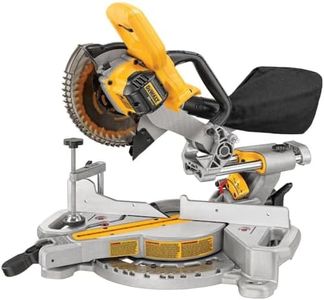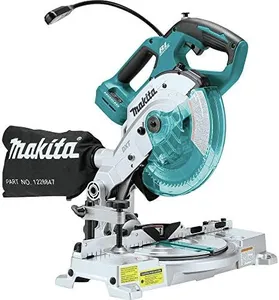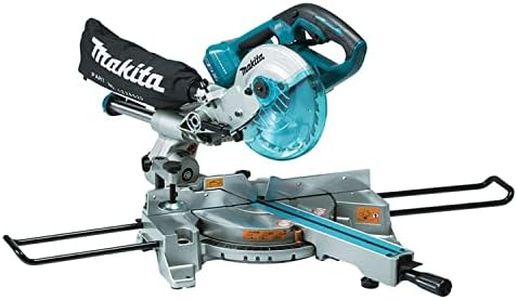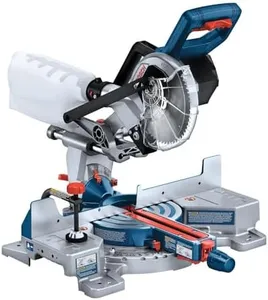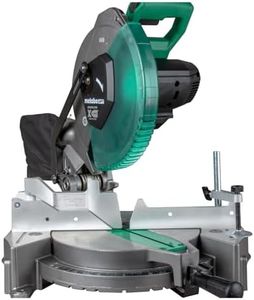We Use CookiesWe use cookies to enhance the security, performance,
functionality and for analytical and promotional activities. By continuing to browse this site you
are agreeing to our privacy policy
10 Best Cordless Mitre Saws
From leading brands and best sellers available on the web.Buying Guide for the Best Cordless Mitre Saws
Choosing a cordless mitre saw can be a little daunting, especially if you're new to woodworking or DIY projects. The right saw can make tasks like cutting trim, frames, or even decking fast, safe, and accurate. It's important to think about what projects you'll work on most, where you'll use the tool, and your experience level. Cordless models offer the advantage of portability and freedom from power cords, which makes them great for use in areas without easy access to electrical outlets. When picking a mitre saw, consider the specs that match your type of work and skill level for the best experience.Blade SizeBlade size is simply the diameter of the circular saw blade that the mitre saw uses. It's important because it determines how deep and wide a cut you can make in a single pass. The most common sizes are 7-1/4 inches, 8-1/2 inches, 10 inches, and 12 inches. Smaller blades (like 7-1/4 or 8-1/2 inches) are lighter and easier to handle, which is great for trim and finishing work or if you move the saw often. Medium blades (10 inches) offer a good balance for general carpentry and most home projects. Larger blades (12 inches) are heavier but capable of cutting wider and thicker lumber, making them best for big framing jobs. Think about what you'll cut most often to pick the blade size that suits your needs.
Cutting CapacityCutting capacity refers to the maximum width and thickness of material the saw can handle, often listed as crosscut, bevel, and mitre capacities. This spec matters because it limits the size of workpieces you can cut in one pass. Simple models may only handle narrower boards (up to about 6 inches wide), while more advanced models can cut much wider boards (sometimes over 12 inches wide with sliding features). If you usually cut smaller trim or molding, a standard capacity is fine. If you plan to cut wider boards for shelving or framing, look for higher capacities. Matching the capacity to your typical projects means fewer workarounds and better efficiency.
Slide MechanismA slide mechanism allows the saw's blade to move forward and backward, enabling you to cut much wider boards than with a non-sliding saw. Sliding saws are a bit larger and heavier, but they’re essential if you plan to handle large materials. If your projects only involve small moldings or occasional home repairs, a fixed (non-sliding) mitre saw may be sufficient. However, if you expect to tackle wider stock or want more flexibility, a sliding model is the way to go. Think about the size of the wood you need to cut to decide if the sliding feature is necessary for you.
Bevel and Mitre RangeBoth bevel and mitre ranges refer to how much you can tilt and rotate the saw blade to make angled cuts. The mitre range (left-right swivel) is for making angled cuts along the width of the material, while the bevel range (blade tilting) is for angled cuts down through the thickness. A single bevel tilts only one way, while dual bevel tilts both left and right, which saves time on complex cuts. If you mostly plan to make simple straight or 45-degree cuts, a basic range will work fine. If you need to make compound cuts (like for crown molding or furniture), a wider range or dual bevel is worth having. Your project goals will help guide which setup you need.
Battery VoltageBattery voltage shows how powerful the cordless saw's motor is. Higher voltage (like 36V, 40V) typically means more power, which is useful for longer running times and tougher materials. Lower voltage (like 18V, 20V) makes for lighter, more compact tools, but they may struggle with thick hardwoods or big projects. If you’re doing heavy-duty work or want to avoid frequent recharges, go with a higher voltage. For lighter work or if portability is most important, a lower voltage can meet your needs. Consider the kind of jobs and how long you'll be working away from an outlet.
Weight and PortabilityWeight affects how easy it is to carry and move the mitre saw between job sites or around your workspace. Lighter saws are easier to transport but may have fewer features or lower capacity. Heavier saws often offer more power, sliding mechanisms, or bigger blades. If you regularly move your tool, prioritize a lighter, more compact model. If the saw will mostly stay in one place, a heavier model with more features might make your work easier and more precise.
Dust CollectionDust collection is about how well the mitre saw captures sawdust while you're cutting, helping to keep your workspace clean and your visibility clear. Cordless mitre saws may have a built-in bag, a port for connecting a vacuum, or both. Better dust collection means less mess and a healthier environment, especially indoors. For home or indoor use, or if you care about cleanup, look for a tool with effective dust features. If you mainly work outside, this may not be as big a concern.
Safety FeaturesSafety features include elements like blade guards, electric brakes, and trigger locks that help protect you during operation. A blade guard covers the saw blade when not cutting, an electric brake stops the blade quickly after you release the trigger, and a trigger lock prevents accidental starts. These features are important for everyone, but especially for beginners. Prioritize safety features if you are newer to power tools or concerned about potential accidents.


